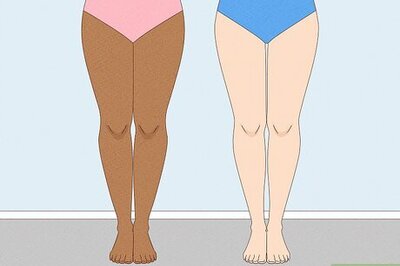
views
Christchurch: International rescue teams intensified their search for earthquake survivors in New Zealand on Thursday, with the death toll nearing 100 and police said they were gravely concerned about the more than 200 people still missing.
Teams from quake-prone countries such as Japan and the United States sent in sniffer dogs and lowered microphones into piles of rubble to probe for signs of life, two days after a 6.3 magnitude quake struck the tourist city of Christchurch.
But their efforts were hindered by the prospect of new collapses of damaged buildings. Fears focused on a teetering 26-storey hotel tower.
Local police commander Dave Cliff said the death toll now stood at 98 and expressed grave concern for 226 still missing. Two infants of five and nine months were among the dead.
"At present we can confirm that we have received a total of 98 bodies. The identification of the remainder will remain a long and complex process," Cliff, police commander of Canterbury province, told reporters.
Cliff had earlier said that the main aim of search teams remained to rescue those trapped, but officials advised caution.
Teams rushed to a small church after it was believed that a woman's voice had been heard -- apparently the first sign in more than 15 hours that people might still be alive. It turned out to be another false hope.
No Signs Of Life
"Right now we do not have any active contact with any person or any indication of signs of life at any location we are working at," fire rescue coordinator Jim Stuart Black said.
Prime Minister John Key said the death toll was certain to rise.
"The indications we're getting from the police ... is that the loss of life could be more substantial than any one of us had ever dreamed of," he told Sky News television.
"They've been in touch with a couple of hundred families who have clearly indicated that they have a loved one missing and police have every reason to believe those people may be fatalities."
Hopes faded by the hour, but there was renewed activity at what was feared to be the deadliest single collapse -- a six-storey building where up to 120 people, including many missing Japanese students, are feared buried.
A newly-arrived Japanese rescue team headed straight for the smouldering ruin of the Canterbury Television (CTV) building. Around 30 of them, in orange and blue overalls, clambered over rubble which also housed a third-floor English-language school.
Other rescuers carried out bodies. Officials brought additional body bags.
"We have a big team and we are determined to help," Kai Jinnai told Reuters. "While we are here we are going to do our very best."
In Japan, chief cabinet spokesman Yukio Edano said 27 Japanese were still missing in the South Island city, with many of those from the King's Education school in the CTV building.
Rescuers faced the risk that a nearby 26-storey hotel could topple at any moment and trigger collapses among other damaged buildings. The Grand Chancellor Hotel was already leaning badly.
"It's incredibly dangerous...if it hits the ground it will create a significant shock wave," Mayor Bob Parker said.
Rescue teams had worked through a second night under floodlights, but found only bodies.
"Miracles happen and we're keeping that in the forefront of our minds. That sort of things drives you and pushes you on," rescue official Keith Norton said.
The last rescue was of a woman, Ann Bodkin, from a finance company building mid-afternoon on Wednesday.
Around 2,500 people had been injured, 164 seriously.
Cliff had earlier said that up to 22 bodies were believed to be trapped in the rubble of the city's stone cathedral, where the spire had toppled onto a square.
More Than 100 Aftershocks
Rescue operations have focused on the central business district, which bore the brunt of the quake on Tuesday afternoon when streets and shops were filled with lunchtime crowds.
More than 100 aftershocks have brought down more debris. Roads have buckled and large pools of water have welled up from broken pipes and sewers.
In places, roads had collapsed into a milky, sand-coloured lake beneath the surface, the result of Christchurch's sandy foundations mixing with subterranean water under the force of the quake. Officials call it "liquefaction" of the ground.
Investment bank JP Morgan estimates the quake could cost insurers $12 billion, while catastrophe modelling firm AIR Worldwide Estimates says the insurance industry faces claims of NZ $5 billion ($3.5 billion) to NZ $11.5 billion ($8 billion).
The quake could end up being the costliest disaster for the global insurance industry in nearly three years. It is not expected to be enough, however, to arrest a sharp multiyear decline in insurance and reinsurance pricing.
Key has been cautious on damage estimates, but said the country could afford to rebuild the city. The prime minister on Thursday reshuffled his cabinet to allow a senior minister to focus on the country's worst natural disaster in 80 years.
Officials said fresh teams from Japan, Taiwan, Australia, Singapore and the United States would allow for an expanded search of three square km littered with flattened buildings.
More than 1,000 workers were expected to comb though shattered buildings, with the city divided into search grids.
















Comments
0 comment